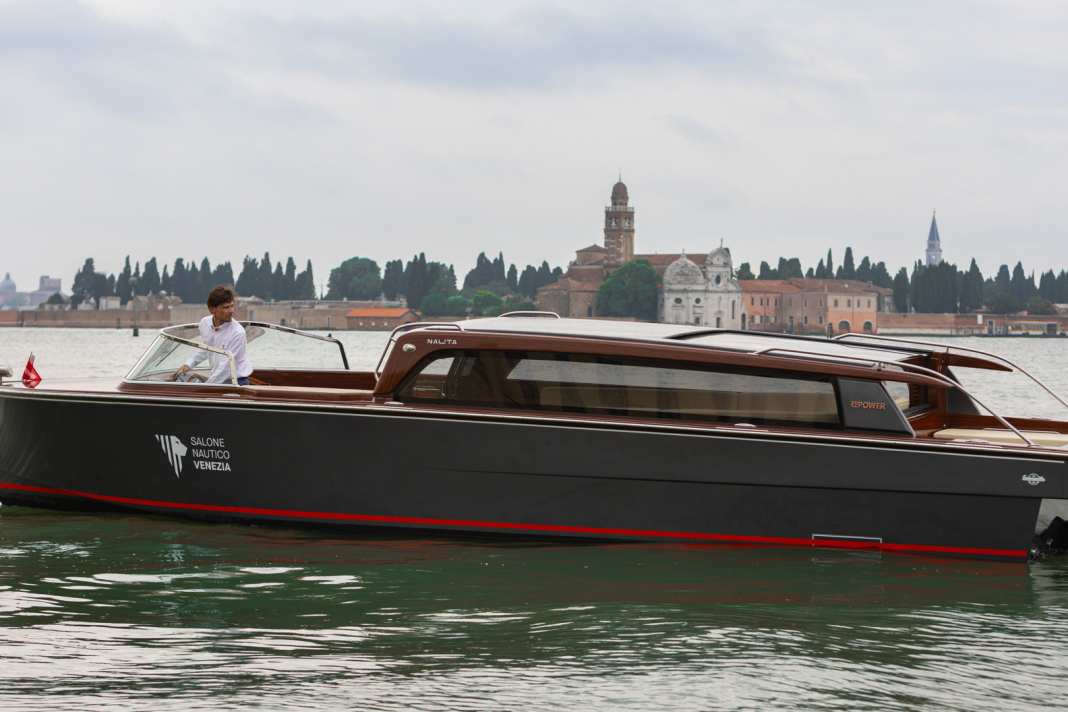





Between the traditional gondolas and water buses, a new type of boat has recently been gliding through the canals of Venice: the "Lucietta", the lagoon city's first electric water taxi. The boat was developed by energy company Repower in collaboration with the Serenella shipyard on Murano and Nauta Design. The project could mark a turning point for passenger transport in the city.
How was "Lucietta" developed?
The development process for the "Lucietta" began with a targeted needs analysis. The designers first conducted a survey among Venetian taxi drivers to determine their requirements. Based on these findings, they decided on a compact design that would enable agile navigation through the narrow waterways while offering space for up to 14 passengers.
With a length of 9.30 metres, a width of 2.25 metres and a draught of 2.10 metres, the boat is perfectly tailored to the spatial limitations of the Venetian canals. The silhouette deliberately takes up the characteristic features of traditional water taxis but adds modern elements, making the boat recognisable as a forward-looking means of transport. Unlike many refit projects, in which existing boats are converted, the "Lucietta" was designed from the ground up as an electric watercraft.
Powerful electric drive for the water taxi
The "Lucietta" runs on a fully electric drive. The engineers have installed an electric motor with an output of 200 kilowatts, which is powered by lithium-ion batteries with a capacity of over 180 kilowatt hours. This configuration enables noiseless and emission-free locomotion without disturbing vibrations - a clear contrast to the noisy combustion engines of conventional water taxis.
More about electric boats:
The maximum speed is 30 knots, although the boat shows its strengths particularly in daily use at lower speeds of between 7 and 20 km/h, which are common in various areas of the lagoon. Performance varies depending on speed and load: At 5 km/h, the "Lucietta" achieves an operating time of 39 hours with a medium load (4,200 kg) and 31.8 hours with a full load (4,650 kg). At 11 km/h, the autonomy is reduced to 19.5 hours with a medium load and 16 hours with a full load, while at 20 km/h, 4 hours with a medium load and 3.2 hours with a full load are still possible.
The loading times
The charging times of the "Lucietta" have been optimised for everyday use. Depending on the available charging infrastructure, the time required to charge from 20 to 100 per cent varies: the process takes just 1.2 hours at a 120 kW charging station, 2.9 hours at a 50 kW charging station and 20.6 hours at a 7 kW charging station. This means that the water taxi can easily be in use for a full working day and then be recharged overnight. The operating costs remain manageable - a full charge costs around 40 euros.
In addition to the electric drive, the "Lucietta" also favours sustainability when it comes to the materials used. The deck and superstructure are made of wood, while carbon fibre is used for the hull. Recycled glass from the waste of the Murano glassworks is also used, which is reused with the expertise of the start-up Rehub. The shape of the hull has also been specially developed to reduce the intensity of the waves. Energy-saving LED technology is used for all lighting elements.
Future prospects for the electric water taxi
"The European Union has set out a path to reduce emissions in the shipping sector," explains Fabio Bocchiola, Managing Director of the Italian headquarters of energy company Repower. "It will therefore be essential to upgrade electric shipping, a sector that is expected to reach a global business volume of around 13 billion dollars by 2030." The "Lucietta" is not Repower's first electric boat project - it builds on the experience gained with the predecessor model "Repowere" and emphasises the Group's commitment to clean mobility, particularly in the tourism sector.
Technical data
Dimensions
- Length: 9.30 metres
- Width: 2.25 metres
- Depth: 2.10 metres
Drive
- Motor type: Fully electric
- Performance: 200 kilowatts
- Battery type: Lithium-ion
- Battery capacity: Over 180 kilowatt hours
- Maximum speed: 30 knots (approx. 56 km/h)
Charging times (from 20% to 100%)
- With 120 kW: 1.2 hours
- With 50 kW: 2.9 hours
- With 7 kW: 20.6 hours
Capacity and costs
- passenger capacity: Up to 14 people
- Cost per full charge: Approx. 40 Euro

